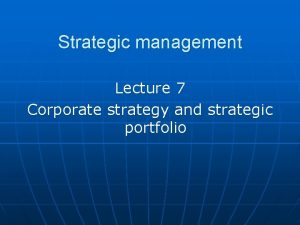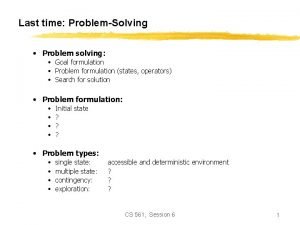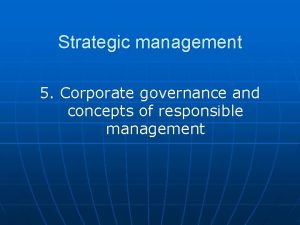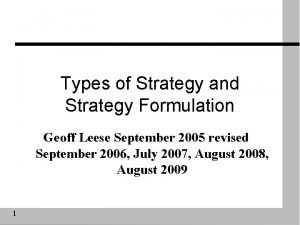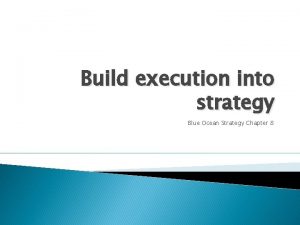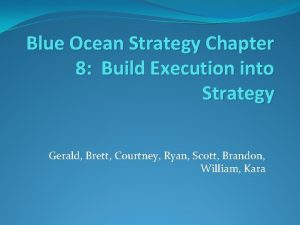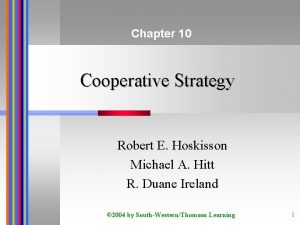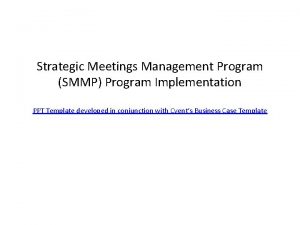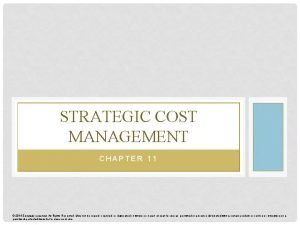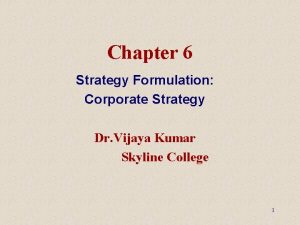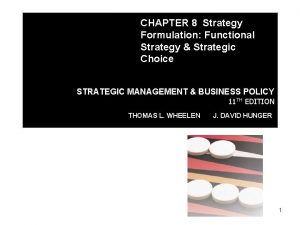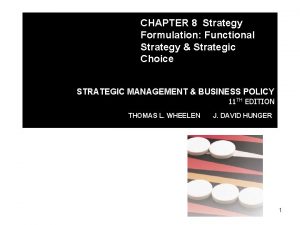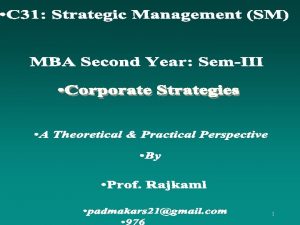CHAPTER 7 Strategy Formulation Corporate Strategy STRATEGIC MANAGEMENT




























- Slides: 28

CHAPTER 7 Strategy Formulation: Corporate Strategy STRATEGIC MANAGEMENT & BUSINESS POLICY 10 TH EDITION THOMAS L. WHEELEN Prentice Hall, Inc. © 2006 J. DAVID HUNGER 7 -1

Corporate Strategy Formula for growth in a mature market (Zook and Allen) A. Push out the boundaries around core business into adjacent businesses. B. Develop a formula for expanding in a predictable, repeatable way. Nike Strategy 1. Establish a leading position for athletic shoes in the new market. 2. Launch a clothing line endorsed by a top athlete. 3. Form distribution lines with key suppliers. 4. Introduce higher margin equipment in the new market. Prentice Hall, Inc. © 2006 7 -2

Corporate Strategy 3 Key Issues – –Firm’s directional strategy –Firm’s portfolio strategy –Firm’s parenting strategy Prentice Hall, Inc. © 2006 7 -3

Corporate Directional Strategies 3 Grand Directional Strategies –Orientation toward growth • Concentration or diversification • Internal development, acquisitions, mergers, or alliances Prentice Hall, Inc. © 2006 7 -4

Corporate Strategy Growth Strategies -- External mechanisms • Mergers • Similar sized firms • Usually friendly • One company results • Acquisitions • Different sized firms • Friendly or hostile takeover • Acquired company becomes subsidiary/division • Strategic alliances • Partnerships • Mutual benefits for members Prentice Hall, Inc. © 2006 7 -5

Corporate Strategy Growth Strategies -– 2 Basic forms • Concentration – current products in same industry • Diversification – different products in different industries Prentice Hall, Inc. © 2006 7 -6

Corporate Strategy Basic Concentration Strategies – (favored by growing firms in growing industries) –Vertical growth (Integration) Move forward (distributors) or backward (suppliers) from your “center of gravity” on the value chain –Horizontal growth (Integration) Geographic or product/service expansion Prentice Hall, Inc. © 2006 7 -7

Corporate Strategy Transaction Cost Economics Three conditions for internalizing a vertical transaction: 1. High level of uncertainty surrounding the transaction 2. Assets are highly specialized 3. Frequent transactions Prentice Hall, Inc. © 2006 7 -8

Corporate Strategy Degree of Vertical Growth -- Vertical integration • Full integration 100% key suppliers and distributors • Taper integration less than 50% • Quasi-integration partially ownership of supplier or distributor • Long-term contract exclusive supplier or distributor (“captive company”) Prentice Hall, Inc. © 2006 7 -9

Corporate Strategy Diversification Mature, consolidated industries push companies to look to other markets/industries for growth Prentice Hall, Inc. © 2006 7 -10

Corporate Strategy Basic Diversification Strategies -–Concentric Diversification synergy of product knowledge, manufacturing capability and/or marketing skills –Conglomerate Diversification Unrelated markets/industries, focusing on financial considerations and sound investment strategy Prentice Hall, Inc. © 2006 7 -11

Corporate Strategy International Entry Options -–Exporting –Licensing –Franchising –Joint Ventures –Acquisitions –Green-Field Development Prentice Hall, Inc. © 2006 7 -12

Corporate Strategy International Entry Options – (limited involvement) –Production Sharing - Outsourcing –Turnkey Operation –BOT Concept (Build, Operate, Transfer) –Management Contracts Prentice Hall, Inc. © 2006 7 -13

Corporate Strategy CISCO acquisition decision rules 1. Is company relatively small? 2. Is it comparable in corporate culture? 3. Is it physically close to one of the existing affiliates? Prentice Hall, Inc. © 2006 7 -14

Corporate Strategy Stability Strategies – Status Quo (common in small businesses) –Pause/proceed with caution Absorb change –No change Future is an extension of the present –Profit strategies Temporary, self serving to management Prentice Hall, Inc. © 2006 7 -15

Corporate Strategy Retrenchment Strategies -Eliminate weaknesses, improve performance –Turnaround contraction/consolidation –Captive Company Strategy angel investor/customer/supplier –Selling out/Divestment sell the company or low growth division –Bankruptcy court settles obligations/restructures –Liquidation termination of the firm Prentice Hall, Inc. © 2006 7 -16

Corporate Strategy Portfolio Analysis -Management views the product lines or business units as investments that should provide a return on investment –Resource commitment on best products to ensure continued success or –Resource commitment on new costly products which may be high risk Prentice Hall, Inc. © 2006 7 -17

Corporate Strategy Boston Consulting Group Growth – Share Matrix – Relative Competitive position Your unit share / share of the largest competitor – Business Growth Rate % market growth Assumptions: – Experience Curve Large Share = Cost advantage – Life Cycle Mature markets = Slow growth Prentice Hall, Inc. © 2006 7 -18

BCG Matrix (Portfolio Analysis) Prentice Hall, Inc. © 2006 7 -19

Corporate Strategy BCG Growth Share Limitations – Too simplistic – Low-share businesses can be profitable – Growth rate is only one aspect of industry – Products/Businesses only consider one competitor – Market share is only one aspect of competitive position Prentice Hall, Inc. © 2006 7 -20

Corporate Strategy GE Business Screen (Mc. Kinsey & Co. ) – Industry Attractiveness market growth rate, industry profitability, size, pricing – Business Strength (competitive position) market share, technology position, profitability, size – Circle size represents the industry sales – Pie slices represent your market share Prentice Hall, Inc. © 2006 7 -21

GE Business Screen (Portfolio Analysis) High Winners A Winners B C Question Marks Industry Attractiveness D Winners E Medium Average Businesses F Losers G Low Profit Producers Strong H Losers Average Weak Business Strength/Competitive Position Prentice Hall, Inc. © 2006 7 -22

Corporate Strategy GE Business Screen Limitations – Complicated and cumbersome – Numerical estimates are subjective – Can not effectively represent new products or developing markets Prentice Hall, Inc. © 2006 7 -23

Corporate Strategy Corporate Parenting Strategy – View the organization in terms of resources and capabilities used to build business unit value and generate synergies across units –Strategic factors “Center of Excellence” –Performance improvement Skill and/or knowledge transfer –Analyze fit Parent strengths and weaknesses Learning Organization + Tacit Knowledge Prentice Hall, Inc. © 2006 7 -24

Corporate Strategy Multipoint Competition and Horizontal Strategies Large multi-business corporations compete against other large multi-business corporations in a number of markets. Potentially reducing competition among industry members. Collusion? ? Prentice Hall, Inc. © 2006 7 -25

CHAPTER 7 Strategy Formulation: Corporate Strategy STRATEGIC MANAGEMENT & BUSINESS POLICY 10 TH EDITION THOMAS L. WHEELEN Prentice Hall, Inc. © 2006 J. DAVID HUNGER 7 -26

Corporate Strategy • What is the future of Internet publishing? • After a brief summary of the publication of the first Internet book, Stephen King’s Riding the Bullet, this exercise asks students to form into small discussion groups to discuss the future of Internet publishing. The exercise proposes some questions as discussion guides, such as what are the pros and cons of Internet publishing. The issue of Internet publishing is an important one for the publishing industry. It has the potential to affect newspapers, periodicals, and books. It is already changing the music industry. For a publisher, its corporate strategy must include the Internet. One could use parenting strategy to assess the fit of a new Internet business unit with a publisher’s more traditional print-oriented units. It appears that the fit between parenting opportunities and parenting characteristics may be high. There are many Internet opportunities to disseminate knowledge and the parent has access to the copyrighted knowledge that is desired by the marketplace. Unfortunately, there appears to be a high likelihood of a mismatch between the strategic factors and the parenting characteristics. Computerization is a strategic factor for Internet businesses, but has been traditionally unimportant for the traditional publisher. For one thing, most of the publishing houses’ backlist are not computerized. Even for their current lists of books, every publisher uses its own combination of packaged and in-house software. As a result, there are probably 2, 000 different formats in use for storing books electronically. This is compounded by the fact that most publishers outsource printing to specialized printers who use their own software with specialized formatting. Moving to Internet publishing could be viewed as part of a horizontal growth strategy. As defined in the chapter, horizontal growth can be achieved by expanding a firm’s products into other geographic locations and/or by increasing the range of products and services offered to current markets. It could easily be argued that the Internet is just another distribution channel for a company’s current products. The problem with this view is that some items may do well on the Internet, while others may not. The issue is which items should be made Internet-accessible? • • Prentice Hall, Inc. © 2006 7 -27

• • Currently, most people do not like reading on their computer screens. Products are being invented which may overcome that resistance. Nevertheless, paper books have many advantages over electronic books. This becomes very clear when students are asked to decide if their textbooks should be electronic or in paper form. They should first understand that there is thus far no real financial savings for buying an electronic over a paper book. Consider that the typical cost of an electronic textbook is about the same as that of a used textbook. Even if the cost of the e-book is slightly less than that of a used paper book, the paper book has some resale value; whereas, the e-book has none. The mystery writer, Patricia Cornwell, proposed that ebooks will not replace paper books. She states, “I see it as an enhancement to the library – a more portable way to have your library with you…. Imagine if you could carry all your textbooks to class in a little handheld computer. ” (“Patricia Cornwell on E-Books, ” PC Magazine, August, 2001, p. 30) Jason Ohler, in his article, “Taming the Technological Beast, ” (January-February, 2001 issue of The Futurist) proposes a useful exercise to evaluate a new technology. He asks students to assume that they are employed by a fictitious Science and Technology Administration and that their job is to analyze the effects of a technology before it is released to the public. He applies his analytical approach to the e-book. Ohler points out, “The e-book is a splendidly mysterious and engaging technology because of its wild-card status. It continues some traditions, modifies others, creates entirely new ones, and in general promises to wreak a slow havoc on life as we know it. ” He sums up the advantages and disadvantages in a chart on page 19 of the January. February, 2001 Futurist. Among the e-book advantages are: environmentally friendly, easier to carry, personalizes the reading experience, easier to swap, harder to censor, and more adaptable to different reading styles. Its disadvantages include the need for an expensive technological infrastructure, increases eyestrain, more expensive, sacrifices depth for breadth of experience, more difficult to enforce copyrights and compensate authors, and displaces workers in traditional publishing. Prentice Hall, Inc. © 2006 7 -28
 Concentric growth strategy
Concentric growth strategy Role of corporate governance in strategy formulation
Role of corporate governance in strategy formulation What is corporate strategy in strategic management
What is corporate strategy in strategic management Why problem formulation follow goal formulation
Why problem formulation follow goal formulation Strategy formulation vs strategy implementation
Strategy formulation vs strategy implementation Corporate governance chain
Corporate governance chain Corporate governance and social responsibility
Corporate governance and social responsibility Corporate governance strategic management
Corporate governance strategic management Business strategy vs corporate strategy
Business strategy vs corporate strategy Strategic competitiveness
Strategic competitiveness Cultural aspects of strategy choice
Cultural aspects of strategy choice Objective of corporate governance
Objective of corporate governance Strategic hrm models
Strategic hrm models Types of strategy formulation
Types of strategy formulation Strategy formulation process
Strategy formulation process Blue water strategy
Blue water strategy A functional strategy
A functional strategy Analysing the 6 strategic options megxit
Analysing the 6 strategic options megxit Formulation of functional strategy
Formulation of functional strategy Managerial process of crafting and executing strategy
Managerial process of crafting and executing strategy Cooperative strategy in strategic management
Cooperative strategy in strategic management Strategic meetings management program
Strategic meetings management program Functional strategy and strategic choice
Functional strategy and strategic choice Functional level strategy
Functional level strategy Maastricht university ib
Maastricht university ib What are the four steps in the portfolio management process
What are the four steps in the portfolio management process Strategic fit vs strategic intent
Strategic fit vs strategic intent Strategic substitute
Strategic substitute Process of strategic cost management
Process of strategic cost management


